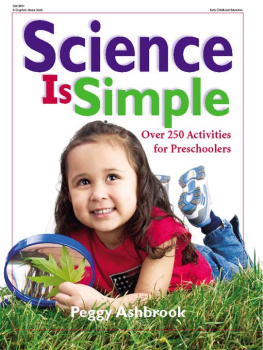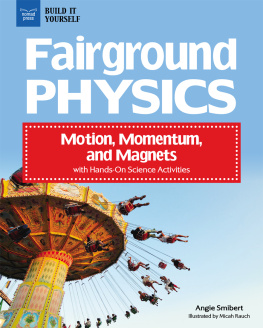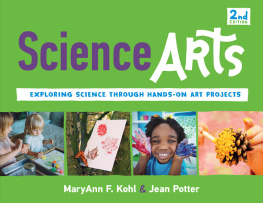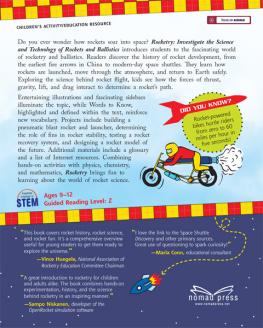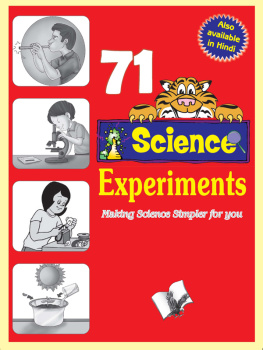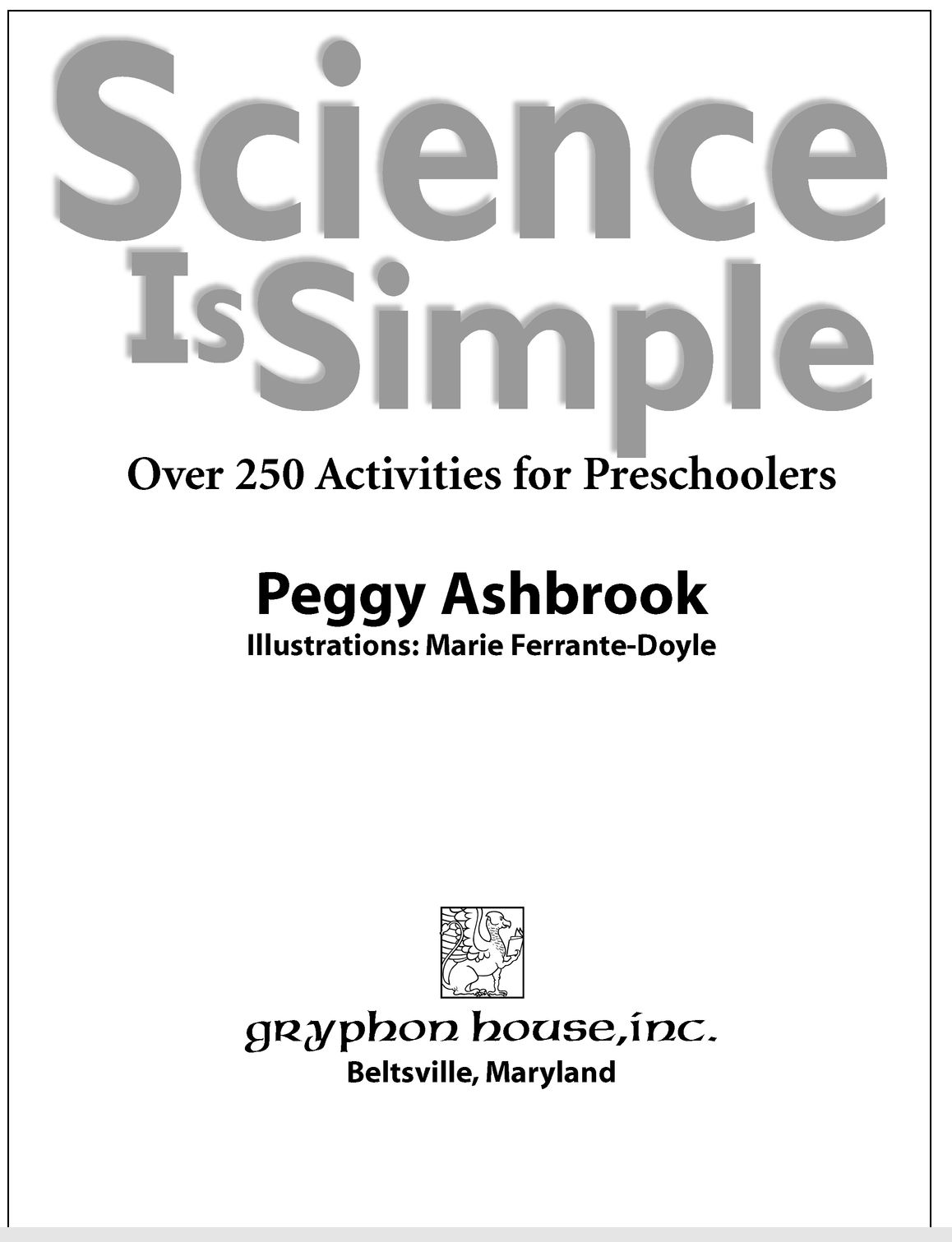Table of Contents
Dedication
To my parents who, as my first teachers, set me on this path
To Helen OHear, my kindergarten teacher, who saw my future
To the children, parents, and staff of Valley Drive Cooperative Preschool, Thank you for doing science with me
And to Darryl, for his encouragement and confidence in me
Acknowledgments
With grateful thanks to the City of Alexandria librarians, especially Linda Sinclair and Lisa Springer, for much help finding books relating to science concepts; to my father-in-law, Pedrito Franois, for the computer that prompted me to start writing; to Kathy Charner, my editor, for her hard work and hand-holding to make the work of this novice into a book and for her wonderful idea to include letters home to parents for each lesson; and to all the preschool teachers who welcomed me into their classrooms.
Note from the Author
Gentle Readers,
Please write to me. I am interested in hearing your thoughts on teaching science to young children, on this book, and on activities in it. You may contact me at scienceissimple@yahoo.com or through Gryphon House, Inc. at 10726 Tucker Street, Beltsville MD 20705. Thank you for doing science with young children.
Peggy Ashbrook
Introduction
Like learning to count or to read, learning how to do science is a lifelong process. Children of all ages benefit from exposure to science situations. They need to be encouraged to experience the world fully, describe what they see, ask questions about it, repeat the experience, and think about the why of it.
By not doing science from the beginning we give our children the idea that it is too hard to attempt. If we want our children to perform well when they are in high school, we need to include science in their early childhood curriculum.
Exposing the children to pre-experimental activities such as collecting rocks, bouncing balls, reading about dinosaurs and cooking (all science activities), giving them the vocabulary to discuss their ideas, and creating opportunities for them to ask questions and seek answersall fit into any early childhood curriculum.
It is quite different to learn about something rather than to experience it. Both kinds of these learning activities are appropriate. For example, dinosaurs fascinate many preschoolers; however, it is impossible to experience these creatures firsthand. Yet, fossils of all kinds can be the subject and the basis for a hands-on experience.
Science Happens Every Day
Many everyday activities offer opportunities to focus on a science concept. Pouring juice is a chance to comment on how the fluid always goes down. Noticing that there is a difference between working with dry sand and wet sand, that water spilled on our clothes evaporates, that leaves move in the wind, that a ball rolls down a slopeall of these ordinary occurrences are opportunities to ask questions to focus childrens attention on why it happens the way it does.
Listen to these preschoolers as they look at and hold roly-poly bugs and slugs. In this everyday experiencelooking at bugs outsidethey are making observations, classifying, using tools, making hypotheses, counting, describing, and drawing conclusions. In other words, they are doing the work of scientists.
Will I see something there.
Natalia Can I hold it? Can I touch it?
Heather I was making it bigger. (Using a magnifier.)
Miguel Look, theres two animals.
Simran Its on your finger!
Maya I like the roly-poly.
Eric Hey, look, theres another one!
Rhea Its just resting.
Sarin Its tickling you, Ja-mante, and it tickled me.
Rose This slug is longer.
Braxton Where is it? Right there! Under the leaf.
Todd Im a slug. (And he slides all the way back to the classroom.)
Brooke This is what you usually do when you dont want your pet to fall. (As the roly-poly moves from hand to hand.)
Amila This one can turn like a ball. (A roly-poly.)
Joey These are yucky, gooey bugs. Im being nice to them.
Josua Theyre looking for something to eat.
Focus on and repeat everyday experiences, such as working with simple machines. Is there a child who practically empties the liquid soap container every time she washes her hands? Fascinated by the feel of the soap or wondering how the pump works, this child needs to repeat the experience to work it out to her own satisfaction. Fill the container with colored water and let her pump until shes satisfied.
If a child can learn, as even three-year-olds do, to distinguish between and pronounce the names of the dinosaurs, such as Brachiosaurus and Tyrannosaurus, then they can learn the words solution, ovipositor, reflect, vibration, and hypothesis. Use scientific words when appropriate, and be consistent in your use.
What If You Dont Have an Interest or Background in Science?
The lessons in this book lead both children and teachers to observe everyday happenings in a focused setting. Just as you do not need to be a fire marshal to draw childrens attention to a passing fire truck, or a doctor to talk with the children about a recent illness, you do not need to know all the answers before teaching about what you see happening in the world.
Common, everyday experiences, such as watching a bird take flight or blowing bubbles, are the basis for the science experiences in this book. It is your willingness to draw the childrens attention to these happenings that is important, not your knowledge or training in science. You do need to be a resource and be willing to model how to look for answers that you do not know. Other teachers and parents are good resources, as are many wonderful science books in the childrens section of your local public library. These books explain scientific concepts in age-appropriate language.
Keep this book nearby during the lesson. It will remind you to ask certain questions that the children may not raise. And it will help you remember that most of what happens in science should be the childrens job. The teachers job is to do the groundwork so that the dominoes will fall into place as the children do the activity.
When Children Have Questions
Most of the science moments you experience with children wont be the only time children will have that experience. They will have other opportunities to build on their knowledge and perhaps come to the same conclusion that an adult does. When a child asks a question, its best to return the question to them by asking, What do you think? After making time for the child to answer the question, you can be a resource for them, as needed.
In addition, encourage children to question everyday experiences. For example, a child might say, Look at this footprint in the mud! Its probably a bear. Although you know this is unlikely (unless you live in bear country), encourage the child to question, wonder, and guess about this science moment. Ask some leading questions such as, How big are bears? Where do bears live? or What other animals live around here? before (if you ever do) telling the child, No, thats a dogs footprint.

